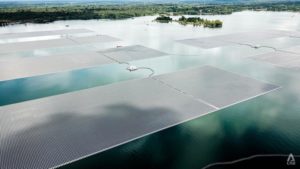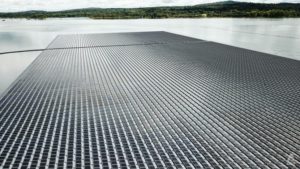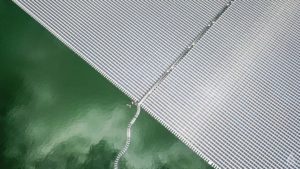
Thailand starts operating massive Sirindhorn floating solar panel project as pressure mounts on climate action
BANGKOK: From the shoreline, the newest piece of Thailand’s renewable energy future is just a shimmer in the distance. The pure scale of this ambitious project is difficult to appreciate from afar.
Forty years ago, the face of this land was shaped by the construction of the Sirindhorn Dam, a then-controversial project designed to provide hydropower and irrigation water to the area. Once again, enterprise is harnessing nature here.
The reservoir is now home to the world’s largest hybrid solar-hydropower project. Installed on the surface of the water are 144,000 separate solar panels, the equivalent of 100 football fields.
The 45 megawatts of peak power the project can produce complements the existing dam operations, which can generate an additional 36MW, and provide electricity across three provinces in eastern Thailand.
The solar panels can make electricity throughout the day while the sun shines, and the hydropower dam can operate at night. Both share the same existing grid transmission lines and transformers.
It is the first of what could be many similar floating solar panel projects rolled out across Thailand, as the country takes early steps to decarbonise its energy sector.

The emerging technology is showing promise and generating interest throughout Southeast Asia. In Singapore, a similar solar panel scheme is operational on Tengeh Reservoir, while plans are underway to rollout similar projects in Malaysia, Indonesia, Vietnam and the Philippines.
This project in Ubon Ratchathani province helps with one of the biggest issues associated with solar power infrastructure development, the scarcity and cost of land.
The surface of the dam is normally unused, except for small-scale local fishing, which can continue even after the installation of the panels.
“Overall, floating PV (photovoltaics) is cheaper compared to a solar farm. We save the land costs and we save the land for Thailand,” said Prasertsak Cherngchawano, a deputy governor of Power Plant Development and Renewable Energy at the Electricity Generating Authority of Thailand (EGAT), the state body in charge of the project.
Prasertsak confirmed plans for another smaller floating solar project in northern Thailand. Following that, he said he expected that the next national power plan would include an expedited strategy to roll out more renewable projects and reduce the environmental burden and economic uncertainty of fossil fuels.
Despite modest increases in renewables capacity, fossil fuels still dominate Thailand’s energy production and overall carbon emissions.
The energy sector is the greatest cause of domestic CO2 emissions, contributing about three quarters of the country’s total.

Thailand has for decades relied on natural gas for energy. Coal plants make up about 20 per cent of energy generation, yet their carbon footprint is huge.
Prasertsak said that EGAT plans to shut down its lignite coal plants in northern Thailand in the near future, once capacity from renewables can replace it.
But energy expert Suphakij Nuntavorakarn said Thailand’s enormous oversupply of electricity, which has been exacerbated by the COVID-19 pandemic, means that heavily polluting power plants need to be phased out as soon as possible, and new fossil fuel infrastructure prevented from being built.
“In the next three to five years we should only allow renewables, because we have this power overcapacity,” said the analyst from the Healthy Public Policy Foundation.
“And because of the climate crisis, we need to develop renewable energy to its full potential.
“A coal phase out is highly feasible and will make a lot of benefits that will compensate for the cost that will be needed to terminate contracts. We should also stop the expansion of new gas power plant projects and LNG infrastructure terminals,” he said.
In order for Thailand to tackle climate change and lower its carbon emissions, he said that emissions should never return to their pre-COVID-19 levels.
Right now though, Thailand’s level of ambition leading into global climate change talks at COP26 in Glasgow appears to be lagging behind other countries.
Source: https://www.channelnewsasia.com/sustainability/thailand-floating-solar-panel-cop26-pledge-climate-change-2274906


